This document aims to detail the cost of the Eiffel Tower. As can be imagined, there are many different types of expenses that come into play when trying to build such a monument. This is indeed the case, and the fact that it was built in the late nineteenth century shows us perfectly detailed accounts and relatively simple to understand, at the time the entrepreneurs had essentially direct expenses.
In total, the Eiffel Tower cost 7,799,401.31 francs.
That's the number advanced by Gustave Eiffel in his book "The 300m tower". It states that 7 392 304.97 francs were in charge, the remainder of 407 096.34 francs was the responsibility of the company operating the tower. How did it come to these numbers? Here.
It begins by detailing the main cost items, which are 3. There is the infrastructure for 666 080.52 francs (Foundations and masonry, 493 373.48 francs, plus the foundations at 147 054.14 francs and the additional masonry at 25 652.90 francs), then the supply and assembly of the superstructure (clogs and counter-support shoes: 35 046.56 francs, Irons and fonts: 3 000 676.56 francs, Montage: 847 399.00 francs, Mechanical parts: 1 153 145.91 francs, Platforms: 607 828.61 francs and Paintings: 125 572.82 francs), and finally total expenses amounting to 956,554.99 francs.
Infrastructure
Wells for foundations 1 and 4
We do not have the details of absolutely all the expenses that have been made on the Eiffel Tower, but sometimes its author mentioned the price spent for this or that activity. The first of these activities concerns the Foundations which was done to know the nature of the basement at the level of foundations 1 and 4, those on the Seine side. The price of such a survey is about 2,800.00 francs, it breaks down as follows:
- Caisson: 1,800 francs
- Labor, machine costs and miscellaneous supplies: 1 000 francs
Foundations
The next cost is the foundations. They firstly break down the price of purchased materials. Secondly, there are the compound prices that have been applied to the different elements of the stock of batteries. This price, necessarily approximate, was compared to those of the accounting for verification. They do not include overhead costs or profits and, as a business price, they should be very significantly increased (by around 15%, except for general excavations, which have been carried out by subcontractors). .
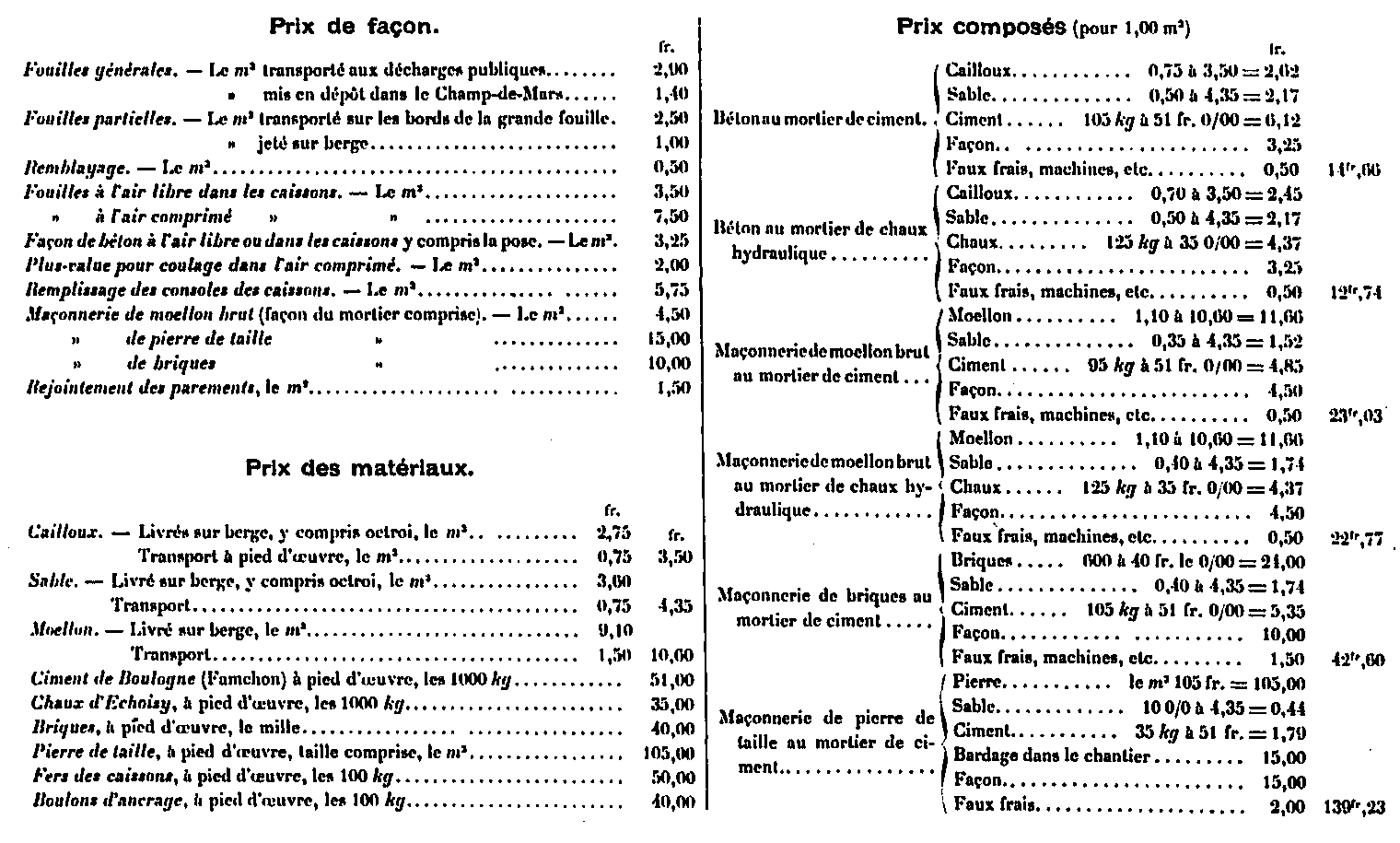
At these prices, it should be added, according to the cost prices given by the accounts:

According to the above prices, we have established the cost price of each of the batteries, separately studying those built by the ordinary processes (Batteries Nos. 2 and 3) and those made by the compressed air process ( Batteries # 4 and 1).
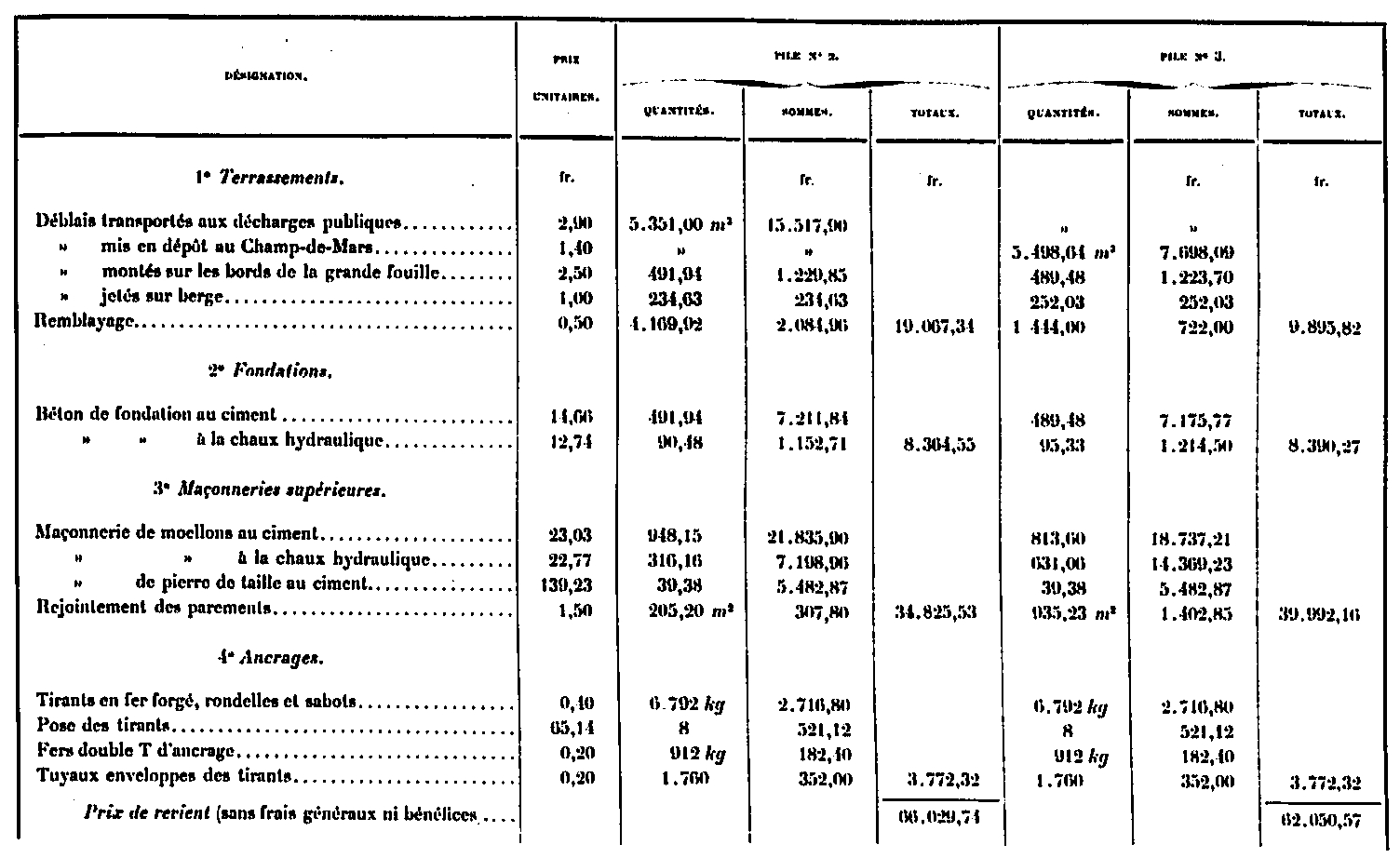
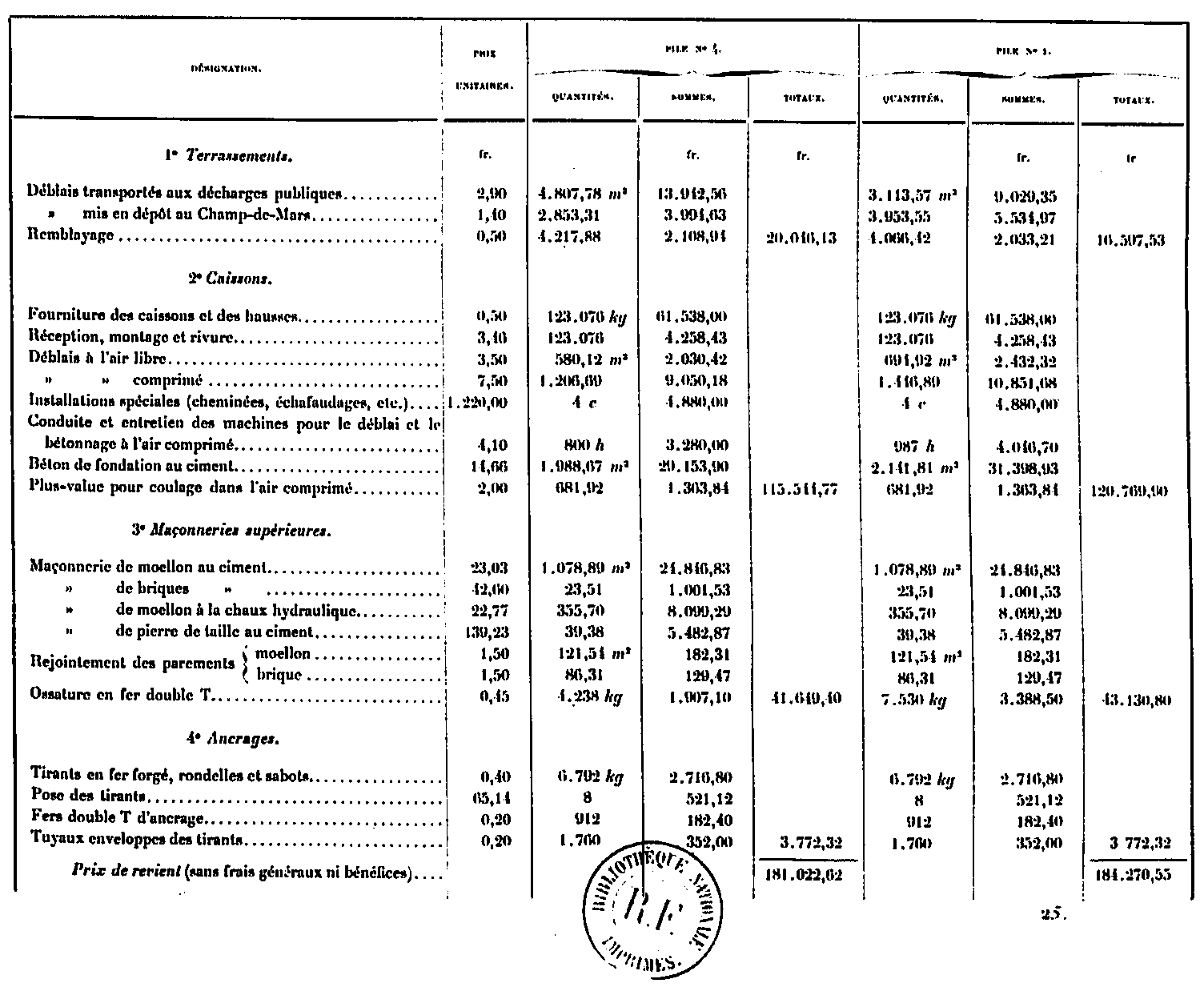
These results can be grouped as follows:

The numbers listed above for Batteries Nos. 4 and 1 make it possible to calculate the average price per cubic meter of foundation by the compressed air method.

As for the bases, the dummy stones treated with MM. Dubos and Cie were the subject of a lump sum amounting to 36,000 francs for the four piles, including 9,000 francs for the supply and 7,000 francs for the installation. The price of this coating, counted per square meter of projection on the plane of the faces, was thus 27 francs
The upper cement throat was made by Mr. Combaz at the price of 13.50 francs per meter surface. The price of the frame was 39 francs per 100 kg for beams and small farmhouses, and 60 francs for the throats of the gorge. The ancillary work that had to be carried out in each stack for the installation of the elevators, and in stack N ° 3, for the installation of the machinery, are summarized in the table below.

The price of these bases for all four piles is as follows:

- Foundations and masonry: 403 373.48 francs
- Bedrock: 147,054, 14 francs
- Additional masonry (machinery and elevators): 25,652.90 francs
- Total expenditure: CHF 666,080.52
Cost of scaffolding stop
The stop scaffolds are those used to mount the pillars up to the height of the 1st floor. They were necessary for, on the one hand that the workers work in acceptable conditions, on the other hand to support the pillars themselves because the more they were mounted, the more their centers of gravity rocked out of the square from which they were supported, and so they went door to door. 4 scaffoldings of this size, capable of climbing to 45m in height, required a lot of wood, the price was felt. This cost price of the frame was the following:
1. Piles
- Wood: 85m2, 43 francs = 3 825 francs
- Threshing: the pile, 35 francs
- Sabot: 5Kg, 40 centimes, 2 francs
- Total: 113 piles, 37 francs, = 4181 francs
- Total of piles: 8 006 francs
2. Structures
- Wood: The cubic meter, 63 francs
- Waste for cuts and joints: 3 francs 15
- Size, lifting, demolition and miscellaneous labor: 46 francs 50
- Let: 112 francs 65
- False fees 5mm: 5 francs 65
- Bolts: 20 Kg to 0.35 francs, or 7 francs
- Total: 125.30 francs
The total of 374m 3 is therefore 374 x 125.30 = 46 862.20 francs, for an all-inclusive cost of 46 862.20 + 8 006 = 54 868.20 francs, which makes 13 700 francs per pillar, approximately.
Superstructure
Cost of scaffolding to mount the beams of the 1st floor
Another scaffolding, the one allowing fix the beams of the 1 st floor. They were built under the beams and had to climb just as high as the stop scaffolds. The price of this scaffolding is:
- Wood: 48 francs the meter
- Waste, cuts and joints 5mm: 2.43 francs
- Size labor, lifting and demolition: 31 franc
- A total of 83.43 francs
- False fees, 5mm: 4.30 francs
- Bolts, 10Kg to 0.35 francs: 3.50 francs
- That is a grand total of CHF 93.23
For the entire Tower, 883 x 93.23 = 82,520.25 francs and about 20,650 francs per scaffolding.
Total expenditure of labor from June 11, 1887 to June 30, 1889
The main cost of the tower was, as was often the case, the workforce. This expense is summarized in the following table:
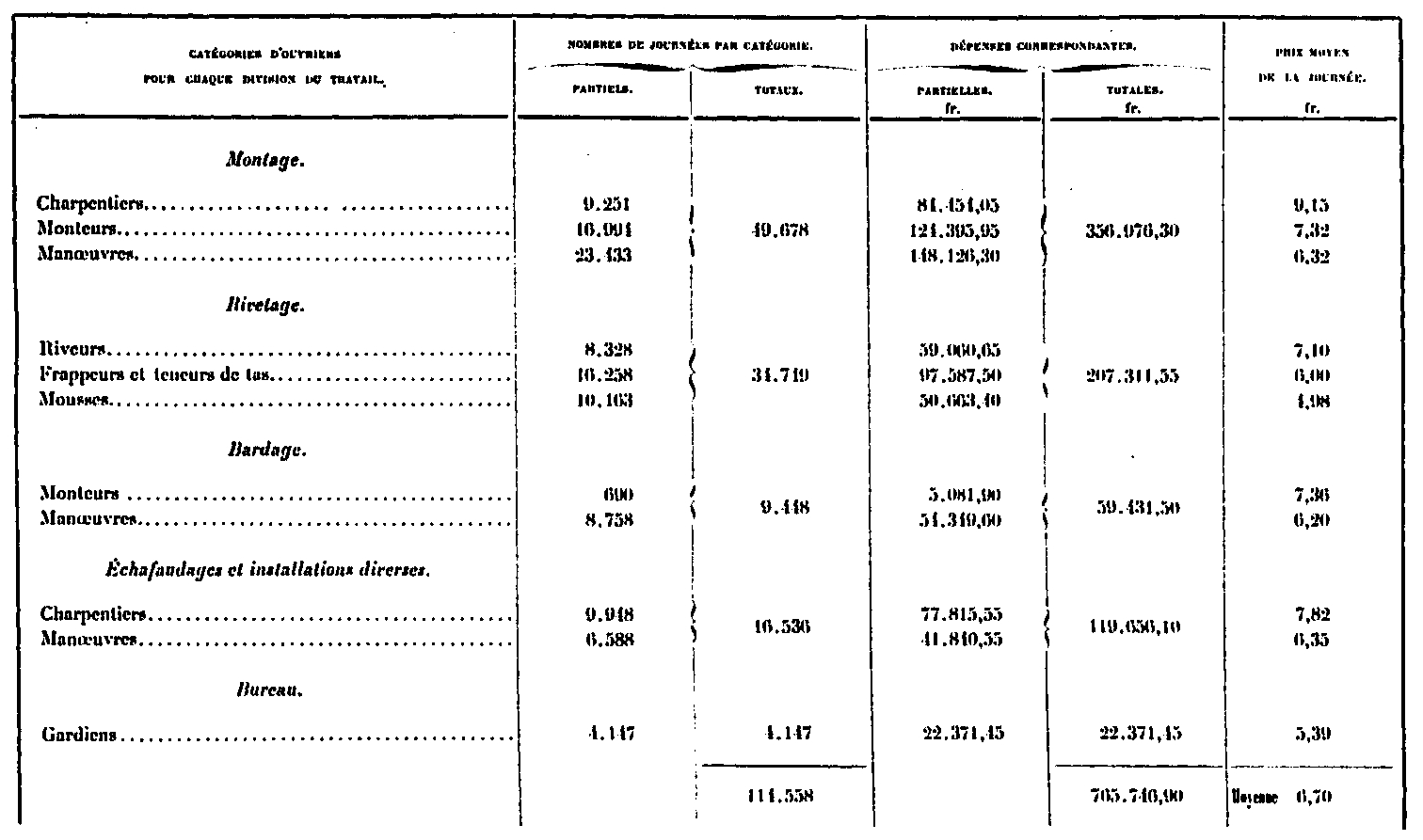
Labor of special works
The preceding global figures can be broken down according to the counting of daily reports, according to the various categories of expenditure.
1 ° Mounting the basements of the piles, which we counted in the chapter of the foundations. This assembly, carried out from September 23, 1888 to January 27, 1889, employed 1,260 man days and cost 8,729.30 francs, according to detail below.

2 ° Installation of Otis lifts.
This assembly, carried out from January 5 to June 13, 1889, employed 4,321 men days and cost 37,279.90 francs, according to detail below.

3 ° Roux-Combaluzier and Lepape lifts.
This assembly, carried out from January 19 to June 8, 1889, employed 3,192 men days and cost 30,842.15 francs, according to the detail below.

4 ° Installation of machines and pumps.
This installation was made from February 11 to April 10, 1889. It employed 155 days of men and cost 1,284.05 francs, according to the detail below.

5 ° Installation of tanks and pipe.
This pose was from March 11 to May 1, 1889. It employed 417 men days and cost $ 4,105.90, as detailed below.

In the table below, we have summed up the number of days per category of workers for these ancillary works and the corresponding expenses.

In the chapter on scaffolding and various installations, it is in the interest of separating the expenses incumbent on the large scaffolds themselves, and those applying to small installations such as the scaffolding of riveters, their movements, the sheers and all other maneuvers. required by the assembly. In fact, these last expenses alone can be considered as having to be directly assigned to the assembly and to enter in its general price.
We gave higher prices for large scaffolding; the related labor is:

By deducting this figure of 49,739.10 francs from the total labor for scaffolding and various installations, which is 119,656.10 francs, we obtain the sum of 69,917.00 francs, which is specially applicable to installations made for assembly.
Structural Assembly Workforce
According to the preceding figures, the general table of manpower, broken down into special works detailed above and in assembly of the frame, is established as follows in number of days:
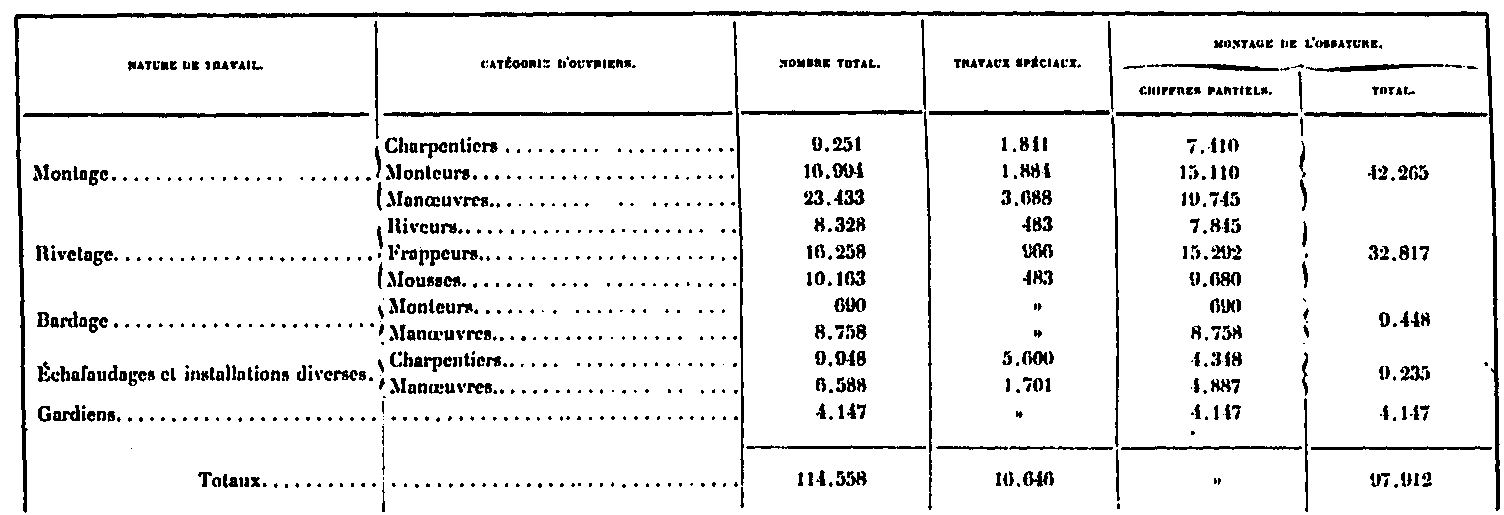
It is likewise established as expenses:

In a nutshell, the assembly of the 6,912 tons composing the framework itself, employed, during 705 actual working days, 97,912 days of workmen, which resulted in this expense of 633,756.50 francs. Which gives per ton an expenditure of 92.00 francs, broken down as follows:
- Assembly: 42.00 francs
- Riveting: 27.80 francs
- Cladding: 8.50 francs
- Special installations: 10.20 francs
- Guarding: 3.50 francs
More detail on: The workers.
Raw materials
The raw material, that is to say essentially the iron, enters for a significant part in the price of the building. The price of materials used for assembly is expressed for 100 Kg, it is given by the accounts:
- 13.25 francs the angles, from 40 mm to 100 mm
- 13,25 francs the 1st and 2nd class merchant irons
- 13,75 francs the third and fourth class merchant irons
- 15.00 francs wide dishes up to 500 mm
- 15.00 francs ordinary sheets
- 15.50 francs striated sheets
- 16.00 francs the special single T irons of the album
- 20,00 francs open and closed angles at required angles
The rivets, they were sold at the price of (always for 100 Kg):
- 18.40 francs the rivets from 18 to 25 mm
- 23.00 francs the rivets of 16 mm
- 25.50 francs the rivets of 14 mm
The suite is a set of other necessary but non-structuring elements for the tower, such as the stairs , railings, colonnades etc. Here is a table summarizing the different expenses, with the weight of each piece.
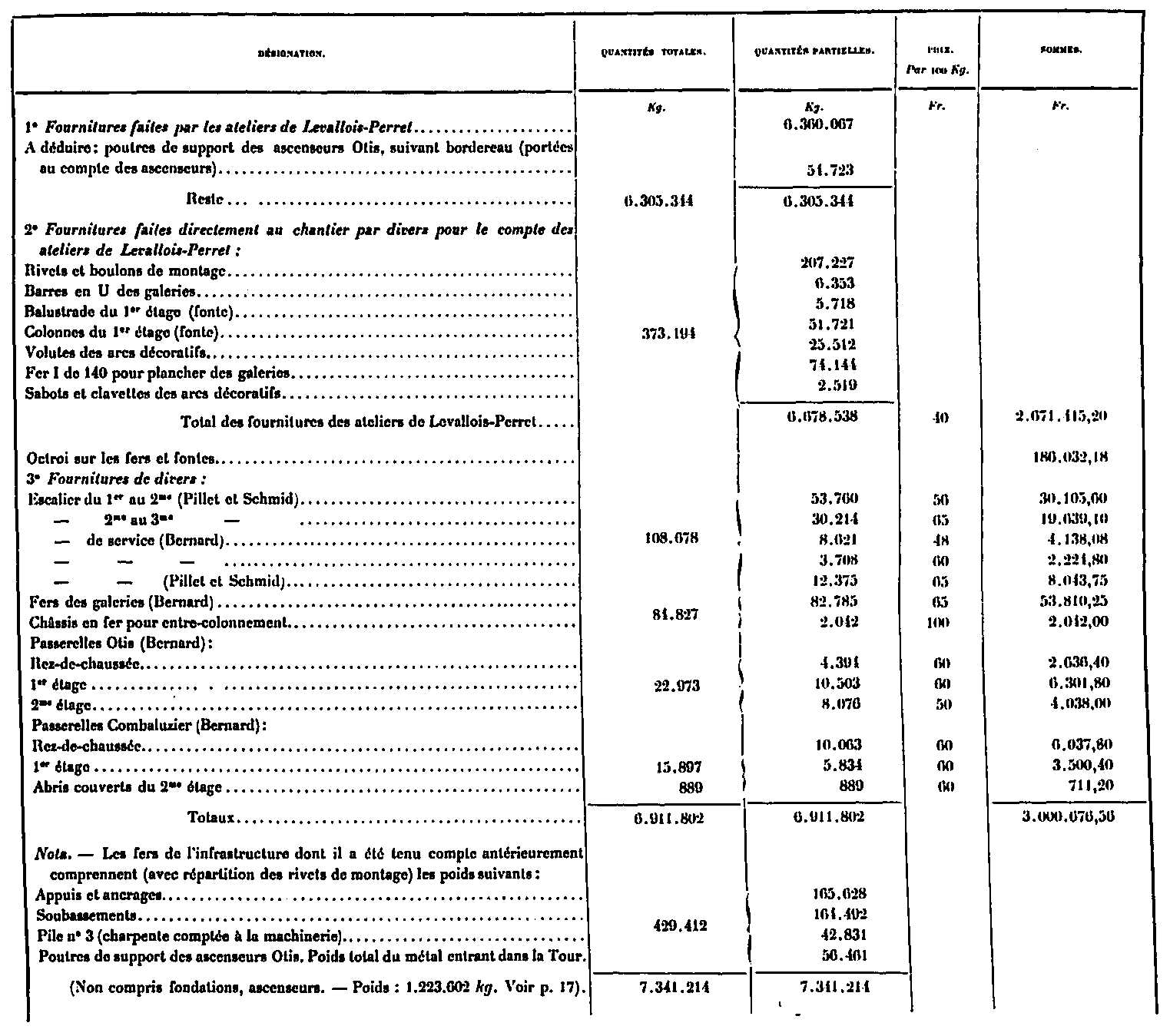
There were other expenses on the materials, due to the manpower:
- Repair and repair of irons: 71.10 francs
- Special cladding systems: CHF 1,223.90
- Riveting (coal and water): 3,770.70 francs
- Scaffolding and various installations, purchase: 117,065.14 francs
- Same, resale: 30 477.35 francs
- Rest: CHF 86,587.79
- Total: CHF 91,653.49
In this total, the large scaffolding (approximately 1,430m3) comes in for a purchase sum, including grants, of 75,575 francs. By applying a sum of 20,000 francs for resale, the price of materials for large scaffolding amounts to 55,575.00 francs. By deducting this cost from the sum of 86,587.79 francs, there remains, for the price of the special installations, 31,012.79 francs.
The total expenditure for the assembly materials is therefore:
- Repair and repair of irons: 71.10 francs
- Special cladding systems: CHF 1,223.90
- Riveting (coal and water): 3,770.70 francs
- Special installation installation: CHF 36,078.49
This price does not include the supply of equipment, including cranes and their chassis, which will be counted later, as well as the general expenses to be distributed. In summary, the expense of the actual assembly of the frame is as follows:
- Manpower: 633 756.50 francs
- Employee benefits: CHF 2,250.00
- Materials for special installations: CHF 36,078.49
- For a total of: CHF 36,078.49
That is 10.75 francs per ton, excluding the large scaffolds, for which the expenditure was:
- Matters (taking into account resale): 55,575.00 francs
- Manpower: 49,739.10 francs
- Total: 105,314.10 francs
That is 1.41 francs per ton (there are 6,912). The cost of mounting the frame, including scaffolding, is thus 847 399.09 francs for 6 912 tons, or 12.19 francs per ton.
More détails on: Origin of the iron.
Otis lifts
When it was built, the Eiffel Tower had two Otis elevators, which are still there, even though they have been renovated. The cost of their poses has been relatively high. Gustave Eiffel, in his book 'The tower of 300m', lists the costs for each room of these elevators in a rather exhaustive table. Here it is.
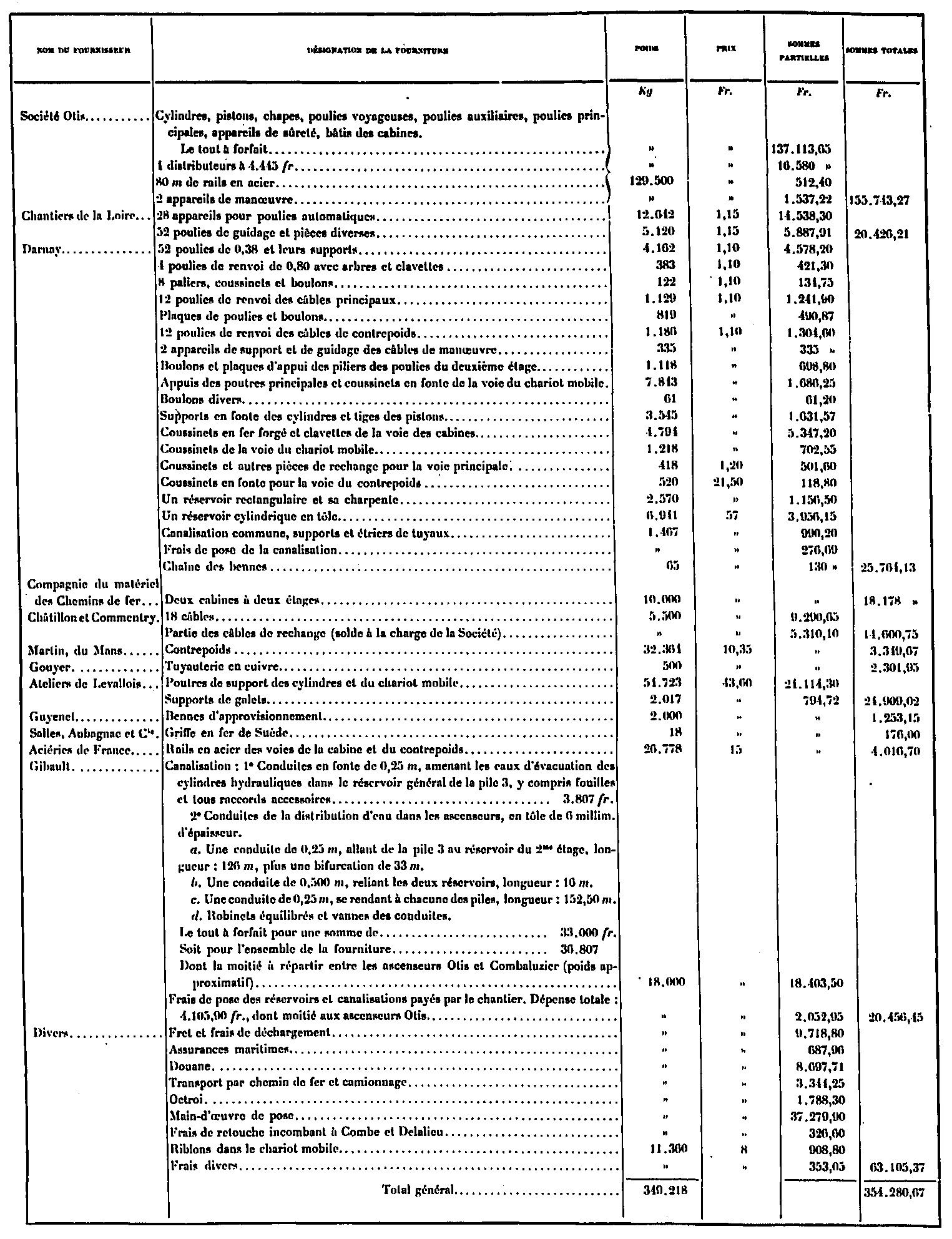
Lifts Roux and Combaluzier
Similarly, the Roux and Combaluzier lifts cost Gustave Eiffel relatively much. The details of these costs are given in the table below, according to the same document. It concerns both double-cabins.
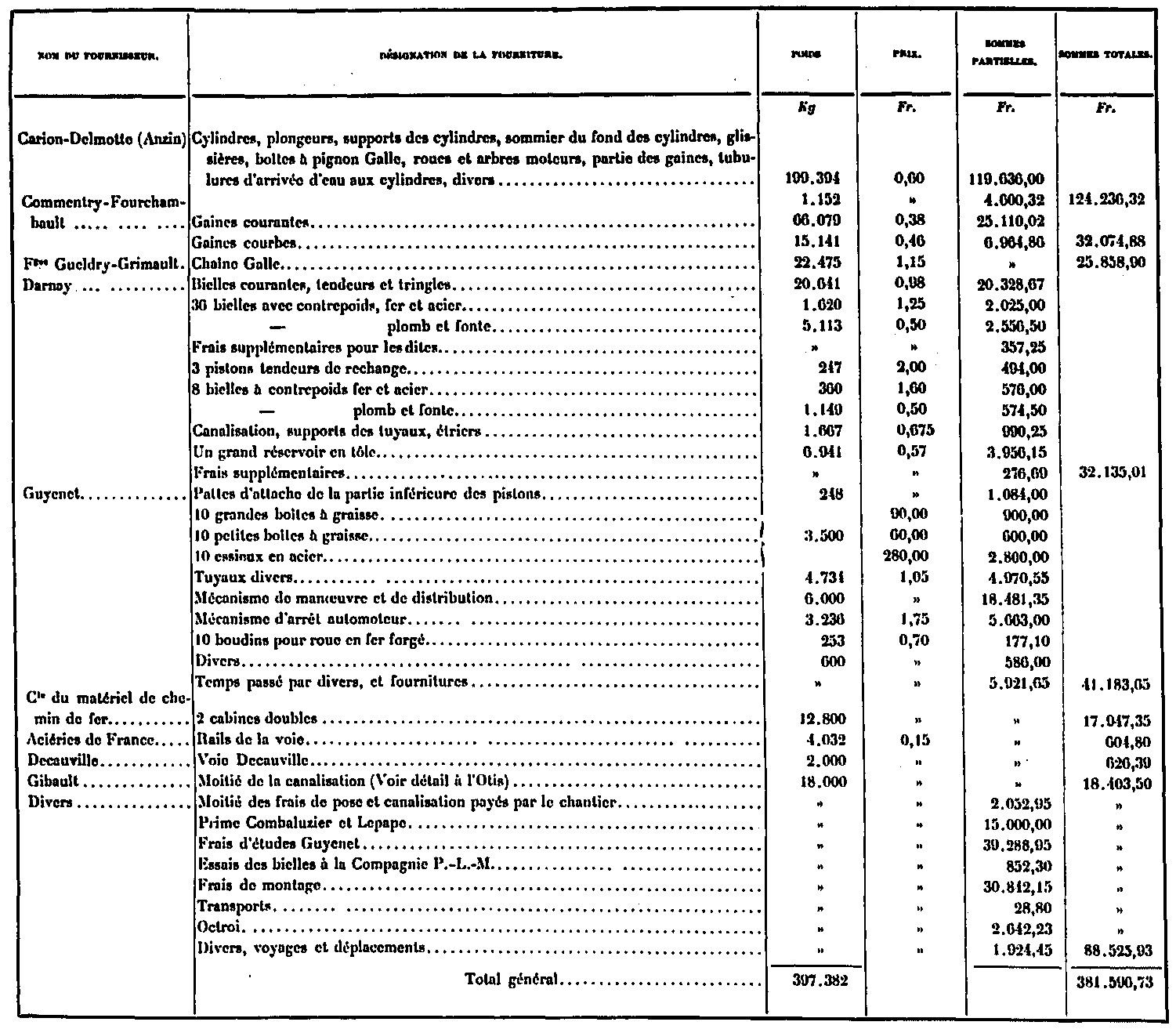
Edoux Lifts
The Edoux lift is very special because it is mechanized by an 80m hydraulic cylinder, and its installation has been particularly difficult, given the working height of the workers. The table below shows the costs, item by item, of the assembly of this elevator.

Equipment
The machines used to operate the hydraulic pumps operating the lifts are quite numerous. It was necessary to use boilers, various engines, auxiliary pumps, and for it to work, it was necessary to join all that together by pipes, special mechanisms, not to mention the ancillary costs, such as the construction of concrete or wooden bases, the carpentry, etc. Here are the details of these costs, which amount to a little less than 200,000 francs.
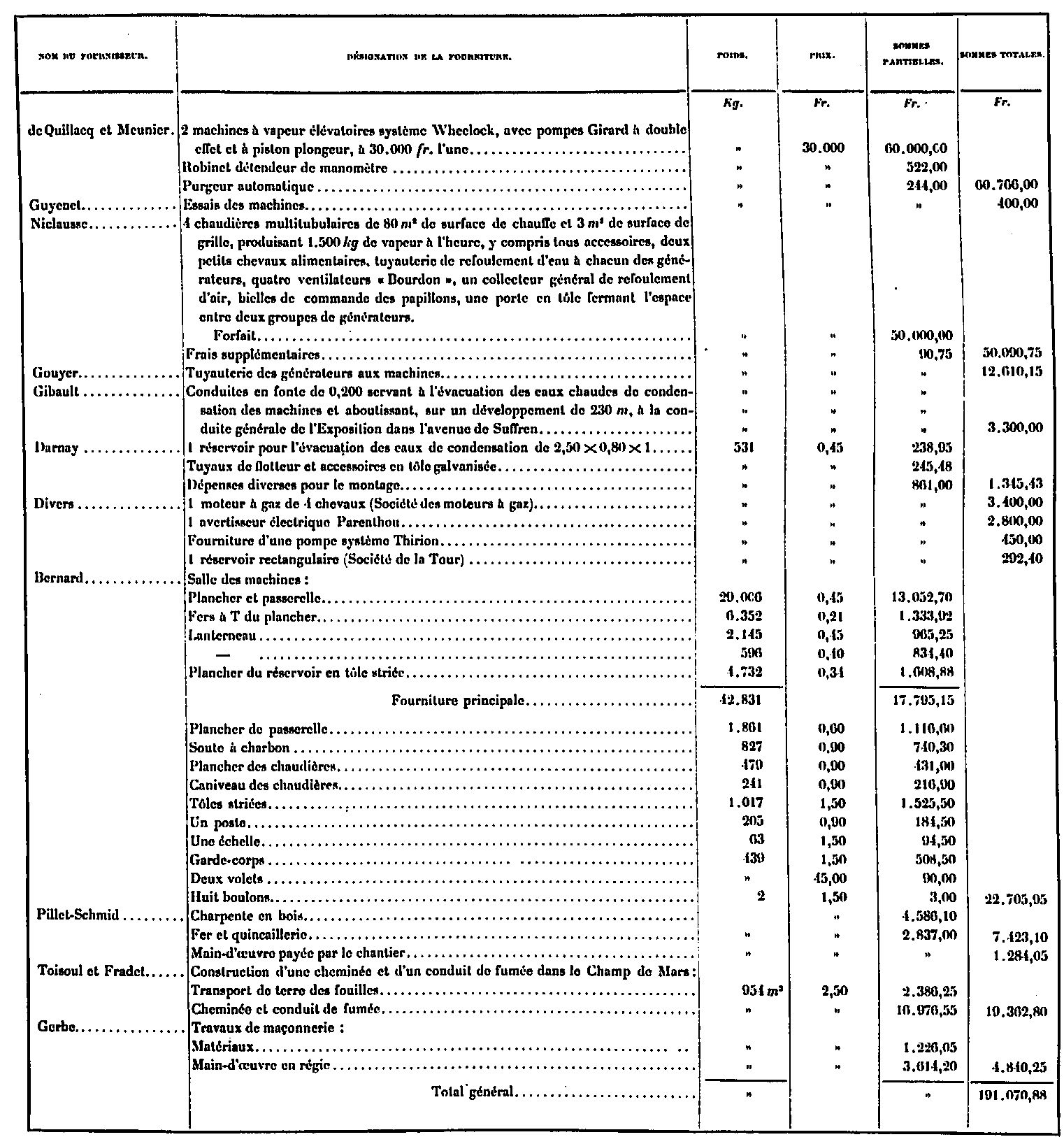
Electrical part
The electrical parts have also had a cost that is not negligible. It is essentially the lighthouse that cost the most, but we must not neglect the other points of the electrical field. Here is the detail, always given by Gustave Eiffel himself. Therefore, costs related to the lighthouse optics, headlamps and electrical service of the newly formed Tower Society were provided by Messrs. Sautter, Harle and Company. These expenses were as follows at the end of the 1889 fiscal year:
- A complete 0.60-meter-diameter, full-beam headlamp with dioptric drum and catadioptric lower part, a rotating drum of colored glass, an electric light regulator.
- Mangin projector of 0.90 diameter, with regulator at 100 amperes.
- A steam engine, pestle type with 2 cylinders compound, actuating, by means of a belt, a dynamo compound, of 300 amperes and 80 volts, and supplying the headlamp and the projector currently envisaged, and, possibly a second projector.
- A distribution board with ammeters, voltmeters, switch and circuit breaker.
- 1,200 m of bare cable and 200 m of insulated cable, 130 porcelain insulators.
- All for a package of 30,000.00 francs.
- Supply of a second Mangin projector 0.90 m in diameter: 5 800,00 francs
- A regulator of 100 amps: 1,000.00 francs
- 600 m of bare cable and 100 m of insulated cable: 1,200.00 francs
- Modification to the distribution board: 150.00 francs
- Total 8,150.00 francs
- Reduction allowed: 650.00 francs
- Package net price: 7,500.00 francs
- Supply of a second pumper-type steam engine, controlling a Gramme dynamo, similar to the previous one: 14 107.50 francs
- Added value for the replacement of the 2 dynamos by 2 S-type dynamos of 600 amperes and 70 volts: 4 750,00 francs
- A Buss tachometer: 525.00
- Or a subtotal of: 19 182,50 francs
- Installation and operation of the devices: 4,268.95 francs
- Miscellaneous supplies: 4 497.30 francs
- Amount of expenses paid by Société de la Tour for the lighthouse and projectors (Sautter invoices): 65 548.75 francs
- Two air pumps with their condensers at 2,700 francs: 5,400.00 francs
- Track and cars of the projectors (invoice Decauville): 891,90 francs
- Electrical service: (bill Sautter)
- Main line of the ground on the 1st floor: 1,170.00 francs
- 1st to 2nd floor: 855.00 francs
- 2nd to 3rd floor: 1,640.70 francs
- 85 lamps mounted on lampshades at 30.85 francs: 2 622.25 francs
- 6 lamps mounted on an iron arm at 30.85 francs: 185.10 francs
- 84 lamps mounted on iron arms at 33.65 francs: 2 826.60 francs
- 51 lamps mounted on equipment supplied by the Société de la Tour, at 27.45 francs: 1,399.95 francs
- 3 candlestick lamps at 32.60 francs: 97.80 francs
- 26 lamps on casings: 748.80 francs
- 44 lamps mounted in lanterns, cast iron heads, at 53.80 francs
- In all 299 lamps for the sum of 13,913.40 francs
- Total lighthouse expenditure and electrical service: 85 754.05 francs
Upstairs Amenities
The layout of the first floor, when it was built, cost 473,807.86 francs, or 107 francs per square meter. The second floor cost 55,512.36 francs (for 39 francs per square meter) and the third 17,419.19 francs (for 69.50 francs per square meter). On this third floor must be added 22,481.82 francs for the 156m2 of the office that was reserved Gustave Eiffel, on the 3rd floor. It gives us a total of 569 251.23 francs to which we must add the cost of the development of the Ground floor which is 38 577.38 francs. The details of these developments are given below on this page.
Finally, it should be noted that the Tower Operations Company during the 1889 Universal Exhibition decided, after the event, to add a number of additional improvements that were not planned at the outset. These developments have been very expensive, the total cost is 265 665.99 francs more. The detail is given below.
Floor prices
To be more precise, the price of the floors was 6 francs per meter for the Perrière floor, 4.50 for the wooden floors, and 4.50 francs for the asphalt, or 15 francs per meter, in average.
Restaurant prices
At the time of its construction the Eiffel Tower was home to various restaurants, the cost of which was:
- French restaurant: 64,437.04 francs, or 184 francs per square meter
- Russian restaurant: 59 530.24 francs, or 170 francs per square meter
- French restaurant: 50 352.10 francs, or 144 francs per square meter
- French restaurant: 48,952.10 francs, or 140 francs per square meter
All the restaurants therefore cost roughly the same, in proportion to their size.
Detail of developments
Below is the table below showing the details of the facilities, platform by platform.
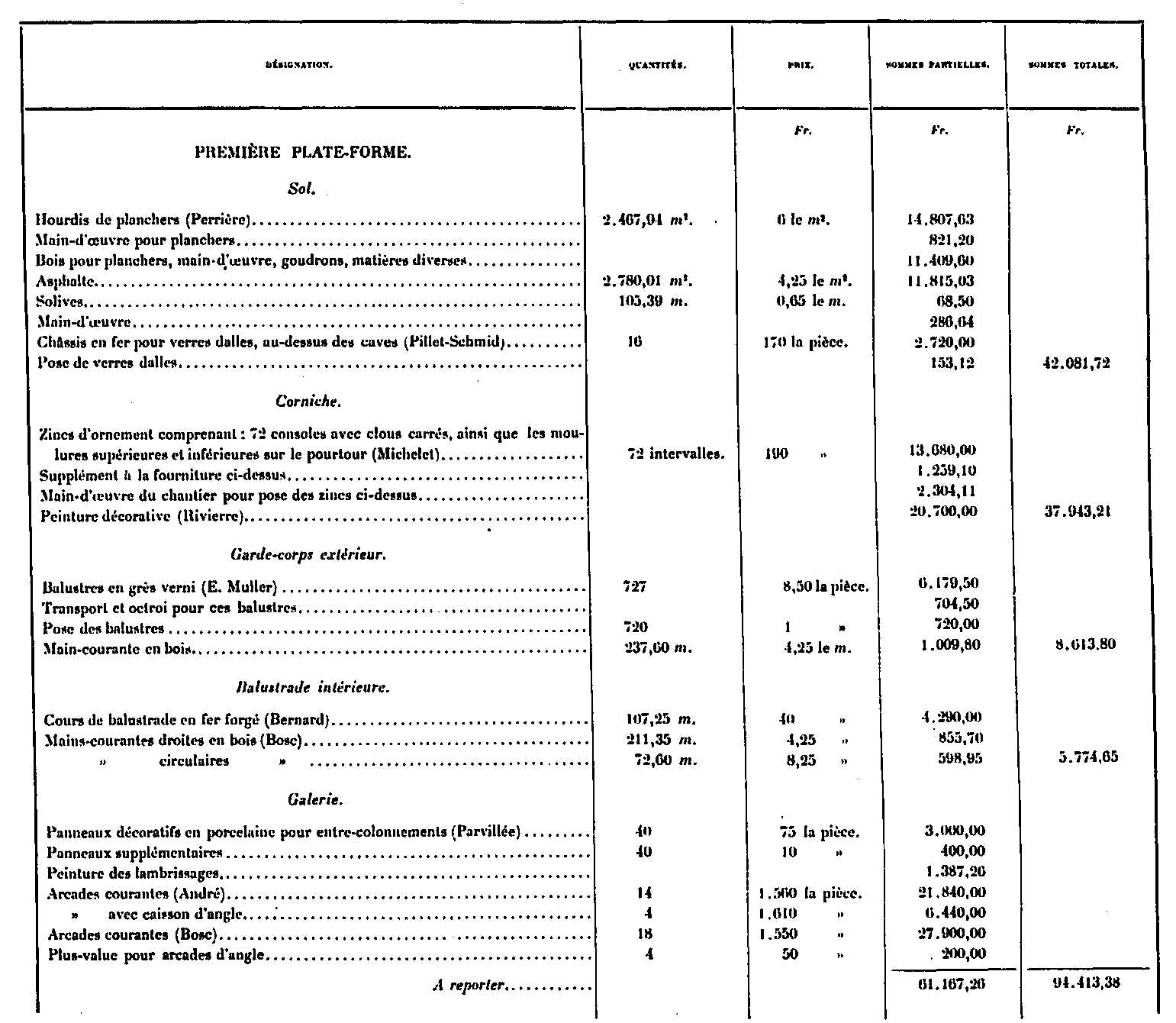
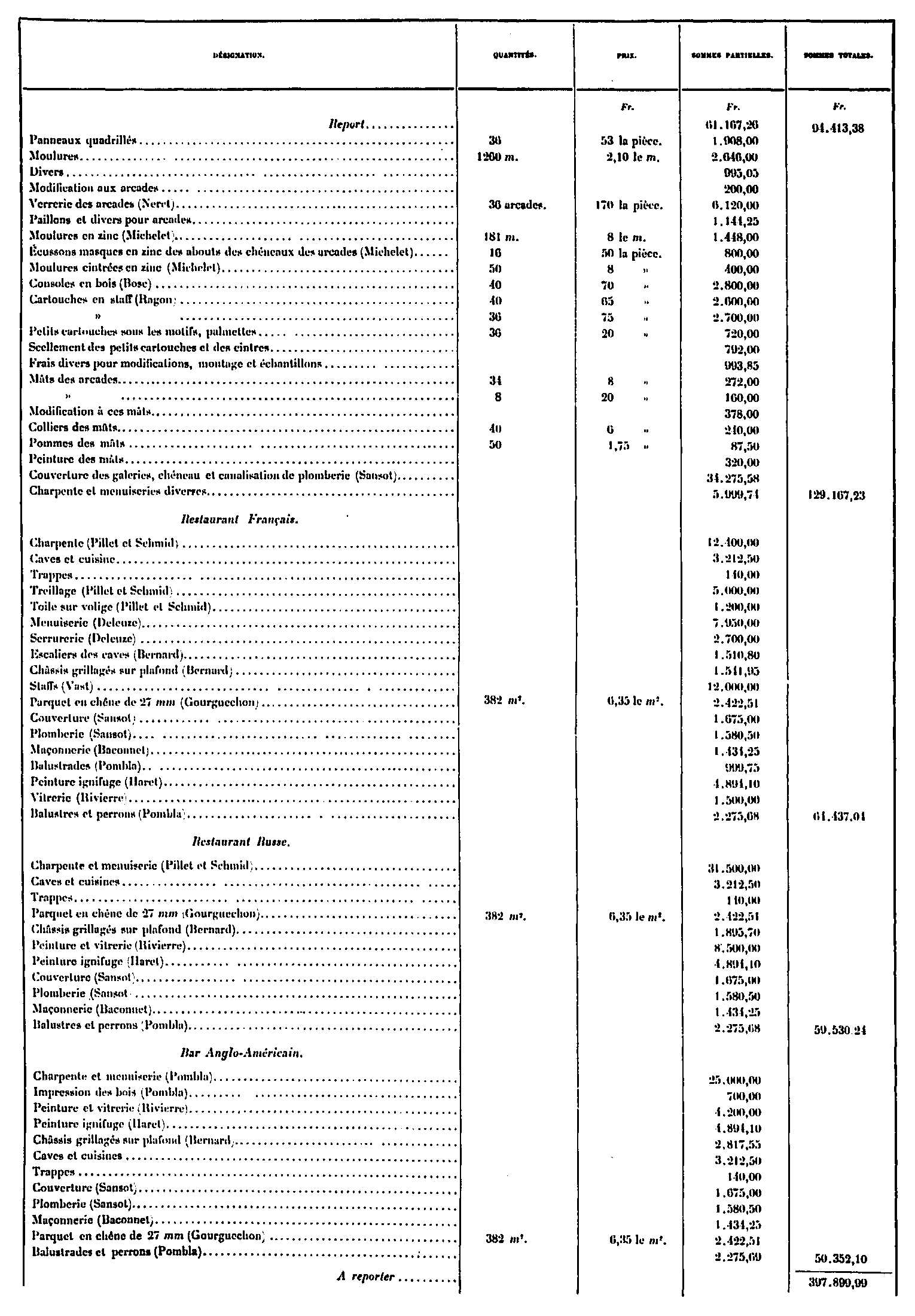
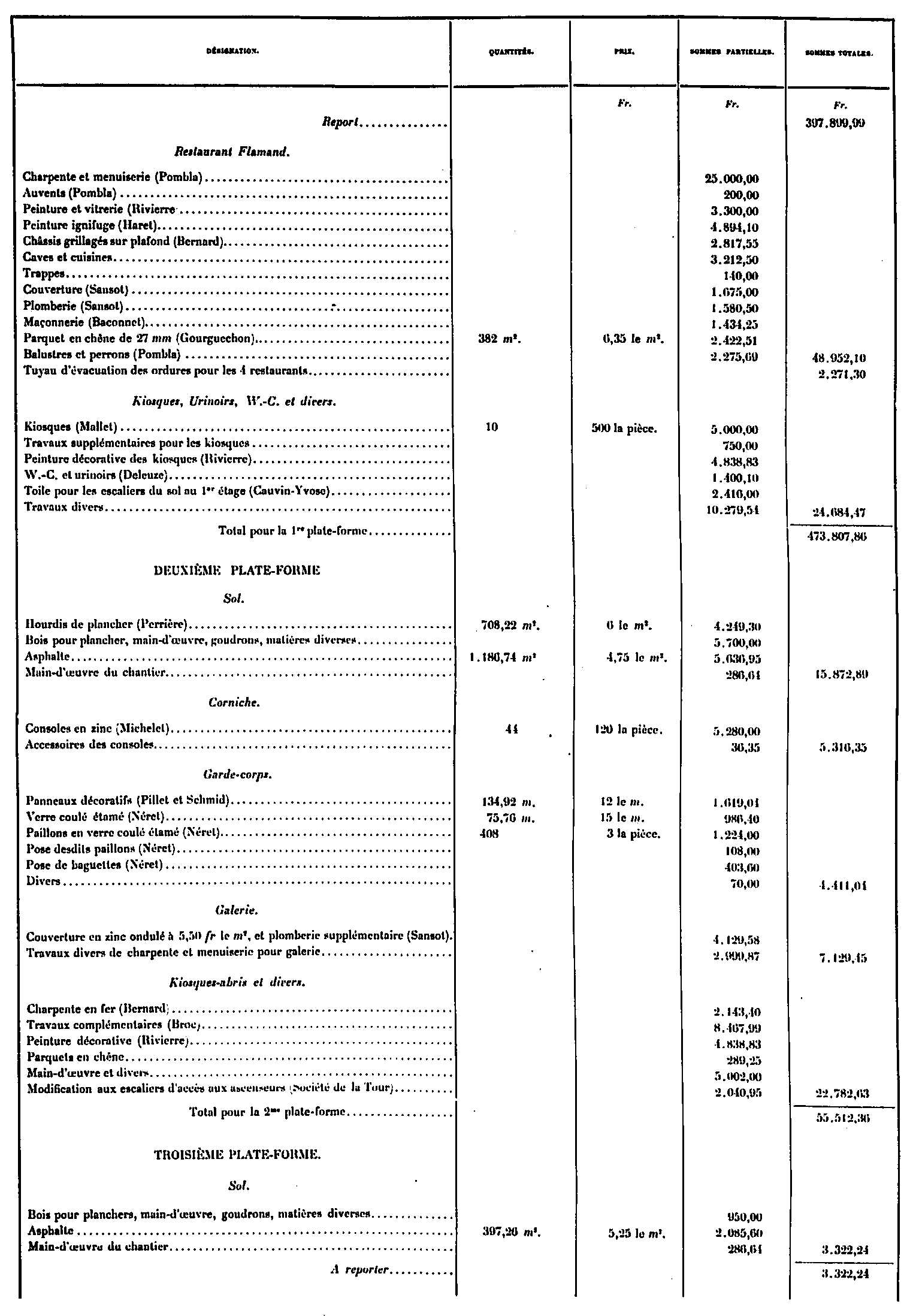
Detail of additional amenities
This table summarizes the additional costs that were incurred by the Eiffel Tower Operating Company just prior to the opening of the 1889 World's Fair. This is in addition to what was initially planned.
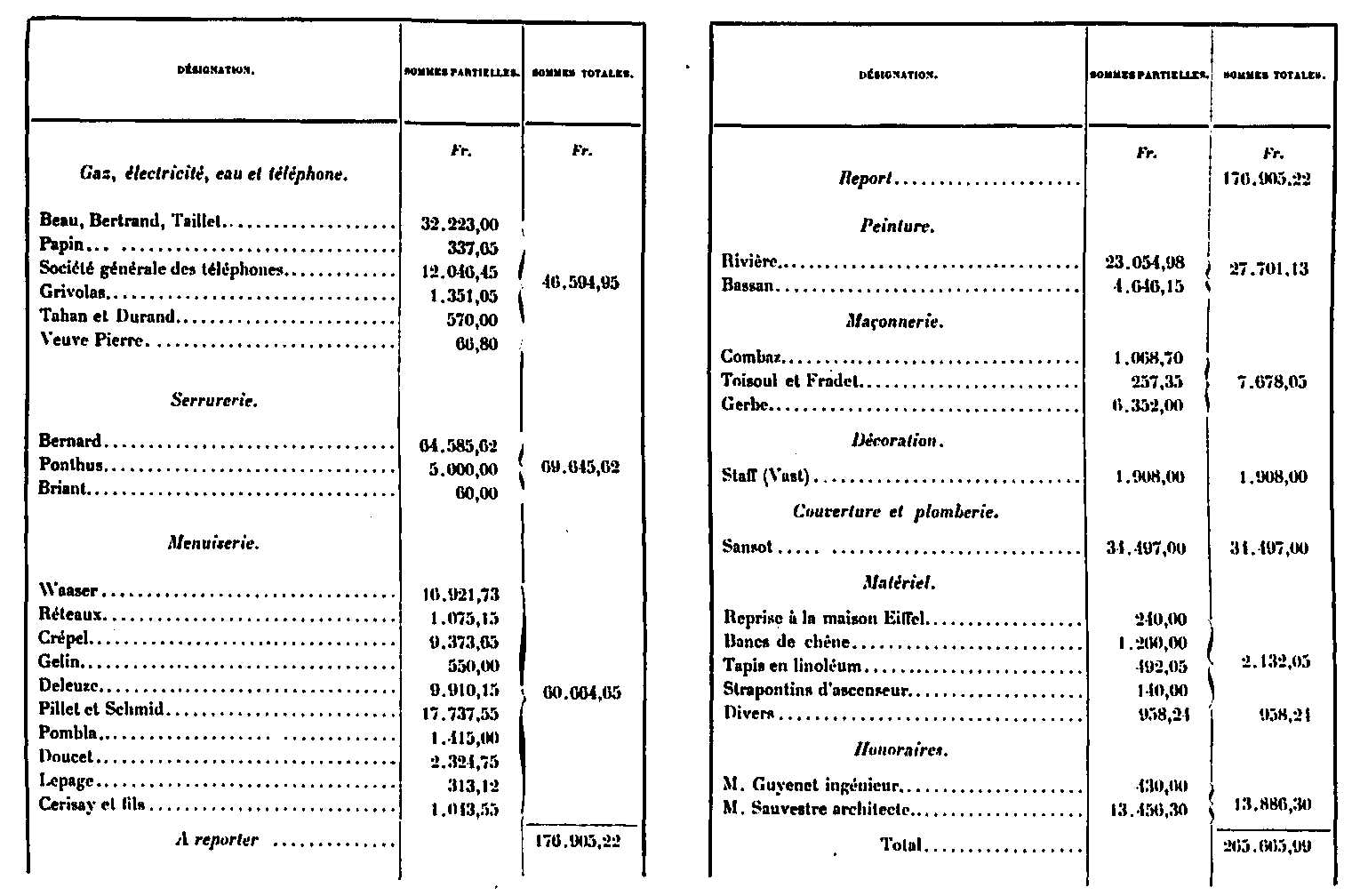
Paint
Painting has been an important budget item, but compared to other items of expenditure the amounts are quite reasonable. This is what Gustave Eiffel mentioned in his book, "The 300m tower", for painting expenses at the time of its construction. Note that you have more information about painting the tower in this folder.
- Laying of the 2nd and 3rd layer of minium by Mr. Nourrisson: 57,328.30 francs
- Laying of the 4th layer by the Company of New Erasers: 60,592.88 francs
- Various alterations during the works: 6085.90 francs
- Painting supplement for pipeline, zinc ornaments, at the Society of New Erasers: 565.74 francs
- Two special scaffoldings for the gallery: 1,000.00 francs
- Total: 125,572.82 francs
Overall expenses
Apart from the expenses listed, there are some very important ones that do not have special applications and must be included in all the work. The main ones are: 1st installation of building sites, 2nd maintenance expenses, 3rd equipment, 4th general expenses. They are summarized in the table below.
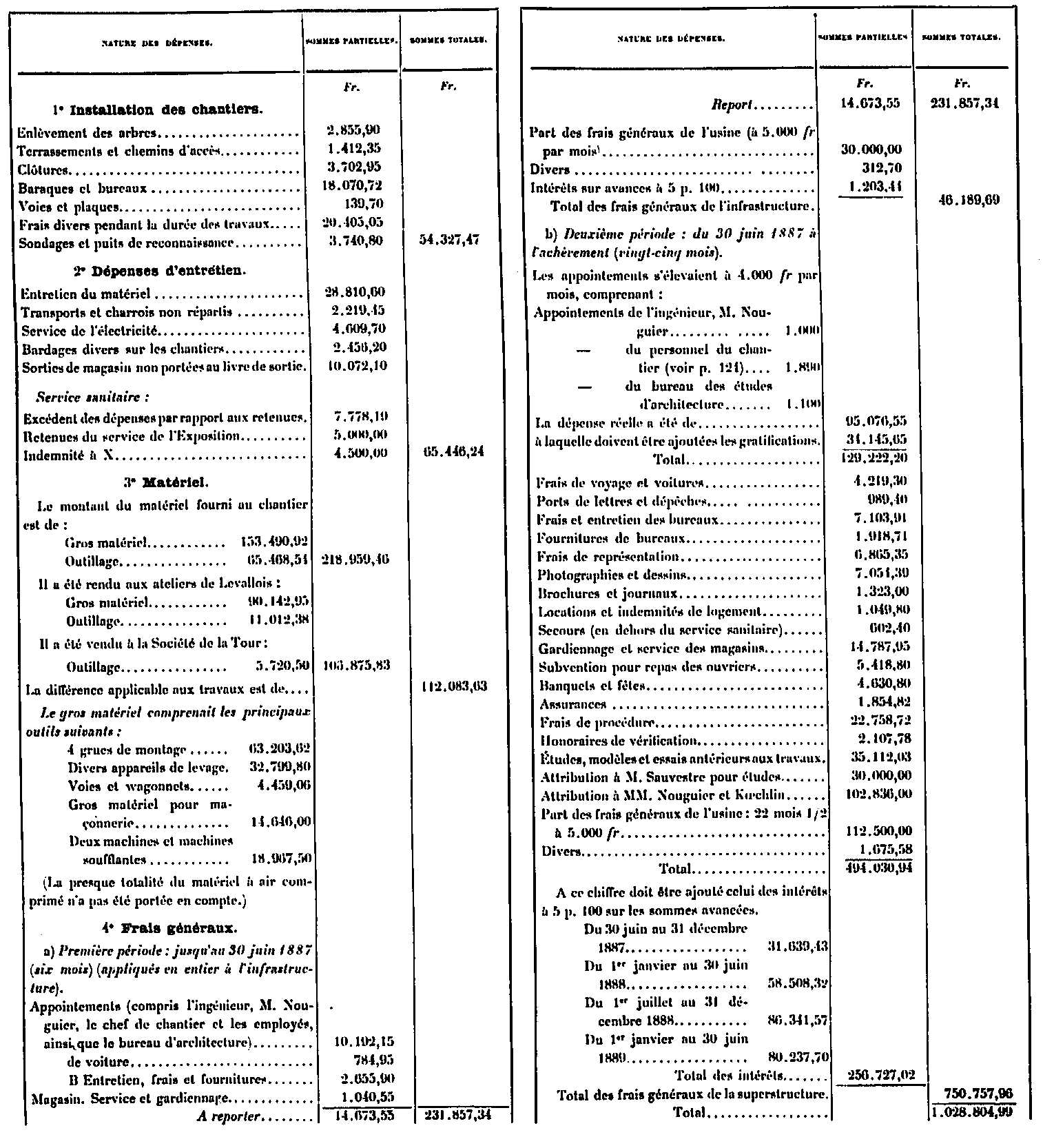
See also:




















